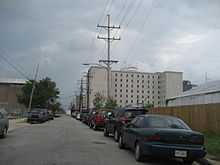University Hospital, New Orleans
| Interim LSU Hospital | |
|---|---|
| LCMC Health | |
 Interim LSU Hospital, New Orleans | |
| Geography | |
| Location | 2021 Perdido St., New Orleans, Louisiana, United States |
| Organization | |
| Funding | Public/Private |
| Affiliated university | Louisiana State University School of Medicine, Tulane University School of Medicine |
| Services | |
| Emergency department | Level 1 Trauma Center |
| Beds | 386[1] |
| History | |
| Founded | 1991 |
| Links | |
| Website | http://www.umcno.org/ |
University Hospital, now called Interim LSU Hospital (ILH), is a teaching hospital located in New Orleans, Louisiana. It is part of LCMC Health.
Organization
University Hospital was one of several teaching hospitals in the state of Louisiana administered by the Louisiana State University System.
In December 2012, it was announced that LSU Health Systems would transfer the management of ILH to Louisiana Children’s Medical Center, a non-profit corporation that manages Children’s Hospital and Touro Infirmary. The plan also called for LCMC to acquire University Medical Center Management Corporation (UMCMC), a non profit corporation originally established to manage and operate the University Medical Center, a $1.2 billion facility scheduled to open in mid-2015.
ILH’s transition from public to private management took place in June 2013. [2]
Interim LSU Hospital is located in the New Orleans Hospital District. It is adjacent to the LSU Health Sciences Center in New Orleans. The address is 2021 Perdido Street, New Orleans, Louisiana 70112-1352.
History
University Hospital was previously known as Hôtel-Dieu (French for House of God) which was operated by the Daughters of Charity. It was purchased by the Louisiana State University System in 1991, and converted into a teaching hospital for the adjacent medical school, which it also oversees.
Like its sister hospital, Charity Hospital, University Hospital sustained severe flood damage during Hurricane Katrina, and its patients were evacuated by boat and helicopter after the storm. In addition to the flood damage to the structure itself, the significant flooding caused the emergency generators to become submerged (as a result of being on the first floor), eventually becoming inundated with floodwater and failing. Another substantial impact caused by the overwhelming flood waters was the devastation to the sewage system. As those employed by the hospital attempted to successfully care for patients while dealing with limited supplies and manpower, the sewage system eventually failed, exposing all occupants of the hospital to potential diseases and illnesses.[3] However, the hospital was extensively renovated and reopened 20 November 2006.
Although staff shortages and other limitations originally only allowed for a capacity of 85 out of 575 beds, the reopening was seen by many as a turning point for New Orleans, having had a severe shortage of emergency care since Katrina. In October 2009, University, with the closure of Charity Hospital, was designated the city's new Level I trauma center, named "Spirit of Charity", and alleviated West Jefferson Medical Center and East Jefferson General Hospital, which had been serving as the trauma centers up until then. [4] As of 2014 the hospital is operating at 235 staffed beds.
The successor of Charity Hospital following Hurricane Katrina, Interim LSU Hospital is the main teaching hospital for LSU Health Sciences Center and currently the only hospital in south Louisiana certified as a Level I Trauma Center by the American College of Surgeons.[5]
Notes
- ↑ http://www.lsuhospitals.org/hospitals/mclno/MCLNO-Profile.htm
- ↑ http://theadvocate.com/news/neworleans/neworleansnews/6338907-123/private-company-takes-over-management
- ↑ deBoisblanc, B. (November 15, 2005). "Black Hawk, Please Come Down Reflections on a Hospital's Struggle to Survive in the Wake of Hurricane Katrina.". American Journal of Respiratory and Critical Care Medicine 172 (10): 1239–40. doi:10.1164/rccm.2509004.
- ↑ "LSU Level 1 Trauma Center Named "Spirit of Charity"". lsuhospitals.org. 2009.
- ↑ http://www.facs.org/trauma/verified.html